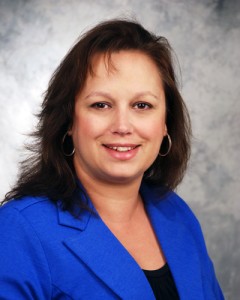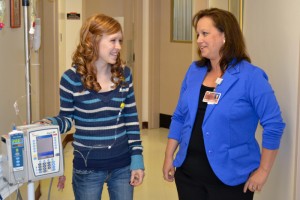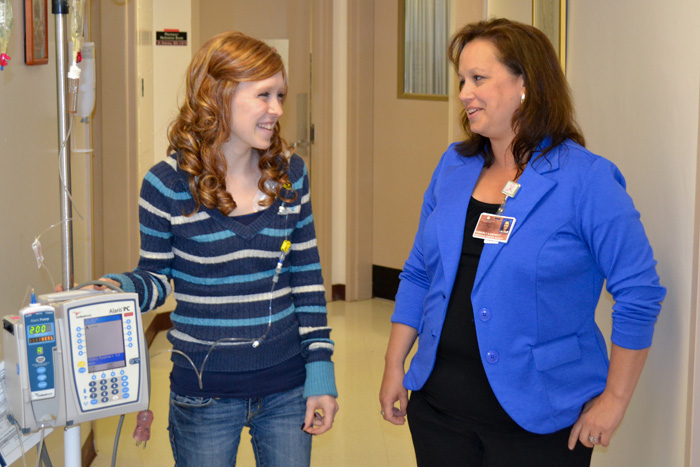
Kim Hackett is used to making regular visits to the Carole and Ray Neag Comprehensive Cancer Center.
She started doing so in 2009, when she was diagnosed with breast cancer. Following her treatments she became a UConn Health Center volunteer.
Now, cancer-free for four years, Hackett is back at the Health Center every day, as UConn’s William Raveis-American Cancer Society Patient Navigator.
“I have to be here for other patients, because I know there are patients out there just like me,” Hackett says. “It’s the people who sit back quietly and want to take care of themselves and don’t want to bother anybody, those are the people who need the American Cancer Society programs and don’t know it. They don’t know what the value of this program is.”
A cancer diagnosis marks the start of a journey that can be overwhelming on many levels. Beyond the emotional and physical tolls and the frequency of medical appointments is the volume of well-intentioned resources available to patients.
“It didn’t hit me for a week,” says Elizabeth Tougas of Ashford, who was diagnosed with ovarian cancer earlier this year—at age 24. “It was a lot to take in.”
As she started to grasp the reality of her situation, she connected with Hackett and learned right away this was someone who could relate to her. They bonded quickly, first about hair loss. Tougas recalled being told it would happen to her within a few weeks of the start of her chemotherapy.
“Kim’s caring, her communication, her support, and being someone to talk to have definitely been helpful,” Tougas says. “She told me how she lost her hair. She’s a good one to relate with. I was nervous about the hair loss, and she went right out and got me a wig.”
Hackett recalls believing she, as a patient, didn’t need the support offered by UConn’s patient navigator program. She didn’t take advantage of it until her treatment was nearly over. But once she did, she was inspired to volunteer.
“You find out very quickly that there’s way more to this program than a packet of brochures,” she says. “There’s a connection to the person who’s in this office, there’s a connection to the other patients who are introduced to you through this office, and there’s a connection to the resources and the people you meet at the American Cancer Society. This becomes an emotional attachment, and survivorship is built sometimes on pure emotion I think. And it’s not just breast cancer.”

“After someone is told they have cancer, they often don’t know what their next steps should be,” says Stephanie Balesano, senior consultant and media relations manager for the American Cancer Society. “The Patient Navigator program is designed to help those newly diagnosed patients and their caregivers by providing personal guidance and increased access to resources and support.”
The American Cancer Society says in Connecticut, over the last five years, the rate of patients using its services went from 1 in 25 to 1 in 5. Hackett, one of only two American Cancer Society patient navigators in Connecticut, says she’s been able to connect with most new patients by their third UConn visit.
Tougas was pregnant and near the end of her term when her tumor was discovered. Her daughter was born healthy and is now 4 months old, the third child for Tougas and her husband.
“There’s a lot of stress on us, as a young family,” Tougas says. “Kim has helped us with coping with everything, including financially. She helped us obtain gift cards [from the American Cancer Society], and is even helping us organize a fundraiser.”
For more information about the pasta supper taking place Nov. 30 at the Elks Lodge, 30 Bissell St. Manchester, call 860-679-7820.
“It’s easy for a patient to get lost in the treatment process,” Hackett says. “And when I say lost, I mean go from appointment to appointment to appointment, and just doing what the doctor says, never really having the time to sit back and think about what they want. This program kind of reminds you from the very beginning that it’s your treatment, this is your path, and there are all kinds of things that can help you through it. We call it a patient navigation program, but it’s truly a resource navigator. It will connect you to the resources within the hospital and to the resources outside of this hospital, in your own individual communities.”
More information about the William Raveis-American Cancer Society Patient Navigator Program is available at http://cancer.uchc.edu/treatment/services/navigator.html. Hackett can be reached at 860-679-7820.
Follow the UConn Health Center on Facebook, Twitter and YouTube.



